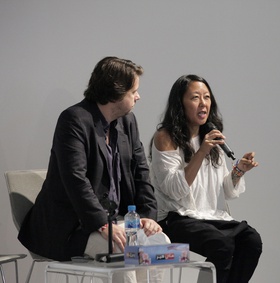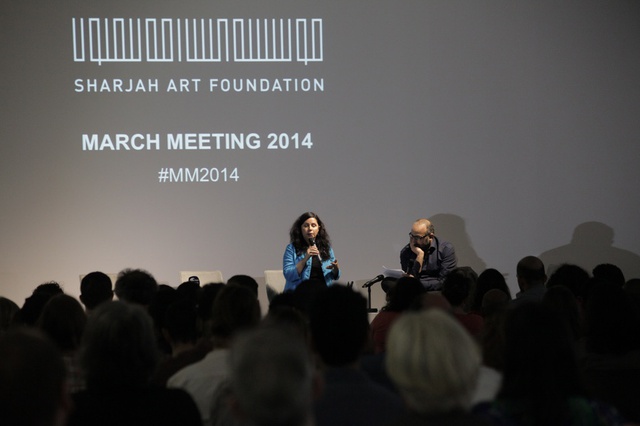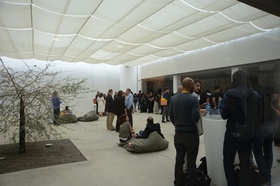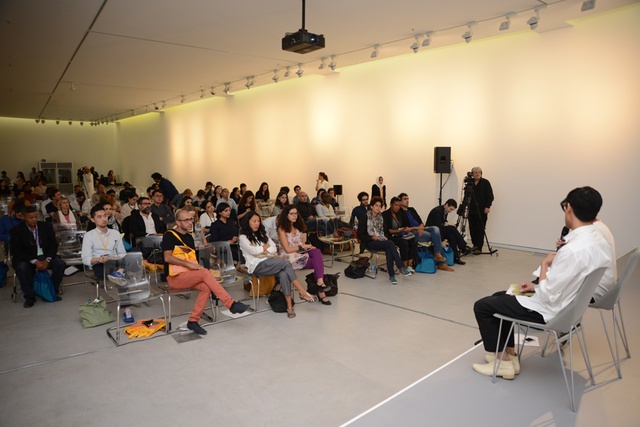Interviews
Positional Views
Eungie Joo in conversation with Stephanie Bailey
Eungie Joo is the former Director of Art and Cultural Programs at Instituto Inhotim in Brumadinho, Brazil, and previously served as Director and Curator of Education and Public Programs at the New Museum of Contemporary Art in New York. In 2014, Joo was appointed Curator of Sharjah Biennial 12 (SB12), which opens in March 2015, and as such, she presided over the programming for the Sharjah Art Foundation's 2014 March Meeting, titled 'Come Together', which brought together artists, curators, writers and other cultural producers to think about the developing themes around SB12, which builds on the foundation's commitment to artistic production, organization and development in the region. The March Meeting acted as a taster for Joo's vision for SB12 as a platform to contemplate how artistsʼ positions help us consider new possibilities for social organization and ways to transcend cultural and political confinement, while thinking about sustained engagement and new commissions. In this interview, which took place during the March Meetings, Joo reflects on the Platform 007 theme of infrastructure.
Stephanie Bailey: I wanted to start with the general question of Platform 007, which is: what is the future of arts infrastructures and audiences in the region?
Eungie Joo: At any given point in your professional life you look at things from a different perspective because you might be in a different place. I have never worked in the UAE before, so I don't have any generalizations to make about it. But I can say that I think it's important in the development of a project that you try to be transparent about your motivations. In the case of the March Meeting 2014 as it can relate to Sharjah Biennial 12, I hope that I have been transparent in my work thus far.
I think we have an incredible resource in the Sharjah Art Foundation, which has been doing very respectable work for a long time – consistently building. And I want to contribute to that and in the process possibly help them to develop a broader audience, both locally and internationally, through different kinds of approaches or even by bringing different people to the table, quite literally in the case of the March Meeting
SB: This is where the question of future infrastructures, especially within the context of the Sharjah Art Foundation, has global relevance in that it raises questions around how we might think of new ways to build new forms and systems.
EJ: I think some of us have certain concerns that are institutional, that are about building infrastructure, and even people that were presenting about institutions and organizations at the March Meeting may have related perspectives, but not the same.
In developing audiences it is very important to help the process of education – not because the public is incapable of approaching contemporary art themselves, but because sometimes contemporary art is intimidating even for so-called experts in the field. We have to be the people who produce the public – not because I have this imagined idea of the poor, unsophisticated public who needs our help, but rather that we need to speak to people who want to hear from us about what we do and why we do it. And that's the way that we develop patronage – not in the sense of the person who donates money to an institution, but in terms of people who will defend the necessity of creative and cultural production in their time.
SB: This is actually where I was going with the last question. When I say that we are all thinking about infrastructures, I am interested in how we look at infrastructure today in terms of developing it through projects such as biennials, for instance, or the March Meeting, or other such events that bring people together and have a stake in the development of future arts infrastructures...
EJ: The development of an infrastructure for contemporary art in Sharjah is already underway – it is not a future, it is a present. It exists. There is a foundation that has grown from a biennial to a foundation – that went from supporting production and residencies in the biennial to supporting autonomous production grant and residency programmes. There is something already happening here. For associate curator Ryan Inouye and me, it is a question of how do we contribute to that by bringing our other skills that were developed in New York or Los Angeles. I think that these things take time – it takes time to understand where you are and how you can contribute – so I'm not exactly sure yet. That's part of the fun and excitement and challenge and horror of what's ahead of me: to see what will unfold.
The March Meeting is purely an experiment – you take all of these people you respect and admire, you shake them up – you put them in place very precisely, but then we shake them up and see what the chemical reaction is. I am not trying to be flip. I really don't know what will be produced from this.
SB: What do you think about what is happening on a more global level? In the last ten years, at least, there have been so many discussions around positions within the art world: the systems we're producing, how we're working together, which is all related to infrastructure in some way...
EJ: I think there are people who think about infrastructure and there are people who do not and who should not, because that's not their gig – especially artists. Some artists are actively engaging themselves in the process, in the dialogue with the institution, and others are not – and it is really not my place to tell them what to do. They do what they do. And I might respond to what they do.
For a variety of reasons, some of which are purely formal, there is no way that we would put that responsibility on people who are brought together for the March Meeting. I would never put it on them that they have a responsibility to build infrastructure. They have a responsibility, but I wouldn't say it's to infrastructure.
SB: This is interesting then because, for me, I think about infrastructure very much in relation to the commons. It's like what Roland Barthes said: if you put a book down and stop reading it, you are still engaged with the narrative. But I think it's interesting when you talk about responsibility – thinking about the Platonian idea of the guardian-philosopher: those who have the responsibility towards society.
EJ: I think that people have different responsibilities. I have a responsibility and rather than critiquing what other people are doing through complaining about it, I try to demonstrate my responsibility through programming and exhibition making, and sometimes writing. But I also try to demonstrate it through the kinds of projects and people I support and the institutions that I support, and even through my own interests. It's not a morality issue, I just really want to put my money where my mouth is, and I have a big mouth. I want to find out if, when an opportunity comes, can I be ready to take that opportunity and to push it a little bit more? And in my case, with infrastructure, I want to support 'marginalized' infrastructures as they're developing or to support 'marginalized' infrastructures that have existed, but we maybe didn't recognize. Part of putting our money where our mouths are is to take something that is happening in Brazil or Sharjah as seriously as something that's happening in New York or Los Angeles. That it does affect me and that I can also affect it.
SB: In terms of your travel and experience of all these different practices and all these different frameworks, what sort of commonalities have you extracted and, from that, how do you see the future? I am not asking for a definite answer, I just wonder what your perspective is.
EJ: I can't speak about commonalities, but I can say that I have had moments when I see a kind of resonance.
I spoke with one of the artists who presented in the last couple of days, and he said that the total experience of attending the March Meetings has been great because as a student he used to attend all the lectures he could find, but now he doesn't have time. He's not necessarily invited to participate or maybe doesn't find a line up where he would participate over several days, so he doesn't attend. But he loves to attend. What these days helped him with was in thinking about his locality and I would say that that's exactly what this experience of going to many places has taught me. It really helped me do programming in Los Angeles, to travel away from Los Angeles and it really helped me do programming in New York. It really helped me understand what was missing. Sheikha Hoor, President of the Sharjah Art Foundation, told me that when she saw Okwui Enwezor's Documenta in 2002, it inspired her to come back and work on the Sharjah Biennial. Because it was such a great demonstration and a positive example of what could be done at that time, what kind of information and art and thinking could be shared and how.
This is the kind of energy that lends itself to more energy – it inspires. And in that way, I think you get this great inspiration from going out to other places: in the challenge of trying to figure out something that you don't know. It makes you sweat a little and makes you really nervous. I am somebody who has lived my life in the USA, and have been to many places and have been exposed to many things that I have understood and not understood. To keep that challenge and to try to share what information I was exposed to and the people that I was exposed to and bring them together in works by artists who are working at the top of their game and maybe they are known locally or regionally but they are not known internationally. I was telling another journalist here about artists who have this kind of a resonance – where you feel as if you've seen the doppelganger of another artist but in a totally different context, maybe religious, philosophical or environmental, so that their expression or form is completely different and yet somehow you start to see it.
SB: That makes me think about the kind of global infrastructure that operates over local scenes, but I'm not referring to this reductive view of the local/global, but rather to infrastructure. You have said that it's not the artists who should think about the art world's infrastructures – that it's not their responsibility. So it's obviously those who are involved in the curation and all the other aspects of the 'creative industry', if we can call it that. But how do you view this global infrastructure that frames the art world?
EJ: Rather than thinking of the local and global I would think more of the microcosmic and macrocosmic. I think we're getting trapped because the reality is that it's not that difficult for you to get on an airplane today. One of the artists left the March Meeting early because she realized that the Etel Adnan exhibition opening was tonight, so she got a plane to Doha, leaving after the last panel to get there. This is our reality. But we also have a microcosmic reality or even existential dilemma. I think that we all exist in a certain place and a certain time – this could be defined as the local – but this place and time right now is much bigger for us. There is no denying it. And I don't know if that is necessarily global, but there is a bigger picture and the bigger picture sometimes can be local. There are people who are really concerned with what is happening locally, they are interacting and engaging with a much larger art world. That might not even be a priority, but rather a reality.
SB: This relates to the actual infrastructures available for artists or cultural practitioners to travel, which is related to the logistics of engaging with the global art world – visas and funding for instance – which raises the issue of circulation…
EJ: It's also about citizenship or a lack of citizenship. When Mohammed Hafiz was speaking about ATHR Gallery, he said that they have to go out because it's not so easy for some visitors to get into Saudi Arabia if they are not GCC citizens. And so they are doing something important there and they are using what they've got the best way that they can and realizing a reality. So these things are all at play.









